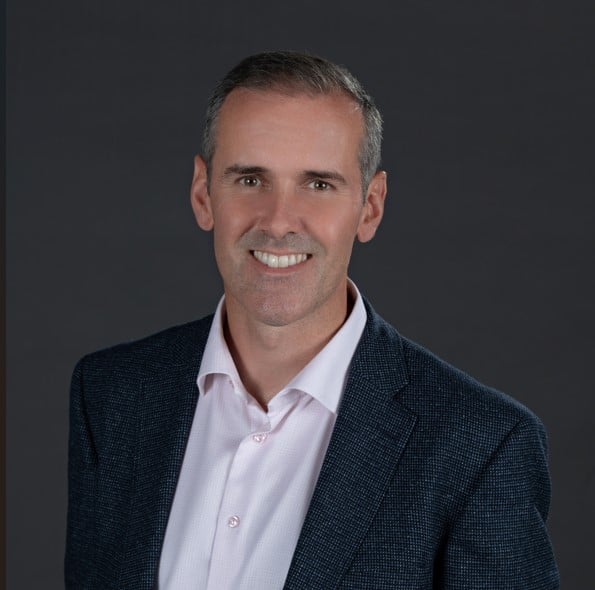By Peter Lantry, Managing Director for Ireland, Equinix

Thomas O’Leary, CIO, ICON
Digital infrastructure and technology are revolutionising how we view expansion and growth in business, reducing the risk and increasing the flexibility. Much of this is thanks to the proliferation of hybrid multi-cloud, which eliminates the need for large investments and a physical presence, instead enabling businesses to test the waters virtually and quickly scale up and down in line with their ever-changing needs.
As one of the leading providers of digital infrastructure globally, Equinix has a key role to play in providing the digital pathways to enable this growth in a sustainable way. By providing enterprises with an efficient, fast path to expansion, we are helping them to increase their geographic footprint while reducing their carbon footprint. In doing so, we are driving a truly sustainable global digital economy.
Highlighting this, our 2024 Global Interconnection Index (GXI) showed that organisations are now connecting with 30% more business partners in twice as many locations. These businesses are integrating technology to fundamentally change operations and electronically deliver value, shifting revenue to digital and digitised services.
To look at how other industry leaders are growing their business through the use of digital infrastructure, I spoke with Thomas O’Leary, CIO of leading healthcare intelligence and clinical research organisation, ICON.
Peter Lantry (PL): Tom, ICON is a true Irish success story; one which is benefitting people across the planet by accelerating the delivery of life-saving medical devices and drugs. Can you outline the scale of the business?
We are a world-leading healthcare intelligence and clinical research organisation, currently employing approximately 41,150 people across 106 locations in 53 countries. Since ICON’s foundation in Dublin in 1990, our mission has been to help our clients to accelerate the development of drugs and devices that save lives and improve quality of life.
At ICON, we work with pharmaceutical, biotechnology, medical device, government and public health organisations. We focus our innovation on the factors that are critical to them – reducing time to market, reducing cost and increasing quality – and our global team of experts has extensive experience in a broad range of therapeutic areas. As such, we are recognised as one of the world’s
leading contract research organisations.
PL: In the last two years, you have overseen enormous growth in ICON. What did this involve from an IT perspective?
In July 2021, ICON acquired PRA Health Sciences in a deal worth approximately $12 billion, paving the way for the leading healthcare intelligence organisation that we are today. An integration of this size is obviously a considerable undertaking. The IT infrastructure is significant in both companies and consequently, it was a huge factor in the acquisition. It was my job as CIO to navigate the often- competing priorities of merging the infrastructure and collaboration capabilities of both companies; combing the best of both business systems to meet market expectations.
This work – along with the implementation of new technologies which enhance team collaboration and streamline workflows – was carried out while maintaining business as usual operations for two very large legacy organisations. This could not have been achieved without the skill and expertise of the enlarged and entire IT organisation, working collaboratively with the key business stakeholders. I am really proud of the role the IT team played in making this acquisition a success.
We are now continuing to scale our business and offerings in all of the markets in which we have a presence. The clinical research industry is a global one, and we are truly a global company in line with that. We are very proud to be an Irish company operating on this scale. ICON has largely grown organically, but we have bolstered our growth through a number of strategic acquisitions which have broadened our service portfolio and have added scale to our existing services. Since we were founded, we have made over 30 acquisitions, both domestically and internationally. This has made ICON a world leader in full-service Phase 2/3 clinical research, as well as the world leader in functional service provision, enabling us to provide our clients with a flexible approach to improving cycle-times, constrain costs and reduce risks in traditional, hybrid and decentralised clinical trial models.
PL: ICON is clearly a company with limitless and exciting ambitions. How will you and your team support this growth?
Our IT team has a multi-pronged approach in how it enables ICON’s growth and expansion plans. We employ our own IT staff, while also working with specialist IT services providers to deliver our services. We also leverage capabilities including robotic process automation, artificial intelligence and machine learning. Supporting this are our centres of excellence dispersed globally and enabling us to operate on a follow-the-sun, 24-hour, 5 days per week basis.
PL: Is flexibility of IT infrastructure important when looking to scale operations or expand to new markets?
As a provider of clinical development services, flexibility is key to how ICON operates and the same is true of the demands placed on our IT. Our IT organisation must be able to support and maintain its own infrastructure, along with the capabilities provided through our cloud partners. Additionally, to meet the often unique requirements of clinical research, we need the capability to develop bespoke solutions which are not available off the shelf. As we are a strategically acquisitive business, we will continue to make acquisitions in the marketplace, and so the IT team is regularly tasked with integration projects and building out or implementing new enterprise-wide platforms.
PL: How do you build that constant requirement for flexibility into the culture and ethos of your IT teams?
The clinical trial industry has always been an environment that necessitates flexibility, consistency, creativity and simplicity; and ICON’s IT organisation is continually tasked with meeting these changing needs. Through our annual budget planning process, we identify the needs of the IT organisation over the following one-to-three years and determine where we need to build out further knowledge and skills internally, while also ensuring we have the correct service partners onboarded to meet future demand. We utilise our forecasting tools and capabilities to identity the type and quantity of resources required, and for what timeframes, and build this into the overall IT roadmap. This roadmap is reviewed and updated on a monthly basis as part of our project review forums, all of which underpins our ability to deliver IT services at ICON successfully.

This article was written by Peter Lantry, Managing Director for Ireland, Equinix
The growth of enterprises like ICON would not be possible without the interconnection provided by companies like Equinix to facilitate a truly global, digital economy. These connections are helping true business value to be realised, with the GXI showing that it enables industry leaders to generate 60%+ more revenue and value. By embracing an interconnected ecosystem, organisations can establish a flexible and extensive digital presence, positioning themselves at the forefront of this movement to take full advantage of the opportunities it presents.
To read more about Equinix’ Global Interconnection Index and learn more about the growth of the digital economy, you can download the report here.



